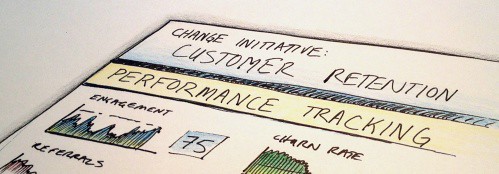We work with a lot of leaders who are responsible for driving change. A common question that they ask us is “How do I show the impact of what we’re doing?” Of course, they have their standard measures (i.e. improved outcomes, increased cost-efficiency, reduced delays, etc), but the following are some of the tricky scenarios that they share with us:
We work with a lot of leaders who are responsible for driving change. A common question that they ask us is “How do I show the impact of what we’re doing?” Of course, they have their standard measures (i.e. improved outcomes, increased cost-efficiency, reduced delays, etc), but the following are some of the tricky scenarios that they share with us:
- “Our numbers don’t show how well we’re doing … what do I do?”
- “It will take a while before we start seeing an impact, but I need to show results now!”
- “The team is really working better now, but we’re still not hitting our targets. How do I prove that it’s worthwhile to keep going?”
Sometimes projects involving change don’t get the support they need to realize to their full potential, but it doesn’t always have to be that way. Here are some tips that Change Leaders can use to set the odds in their favor:
Tip 1: Begin with the end in mind
In addition to being one of my favorite Stephen Covey habits, beginning with the end in mind is incredibly practical tool for successful projects. When leaders are driving change this concept applies equally well. Some examples of applying this to change initiatives include:
- Getting crystal clear on how things will be better once your change initiative is complete. Think about the conversations you will have in that future state, such as, “We’re way better at retaining our customers than we were in the past”. Then think about the numbers that you’d like to say to back it up, such as “We’ve decreased our customer churn rate by 60%”. In order to do these comparisons in the future you will need a baseline reading of your current performance. This thought exercise can be an easy way of identifying the performance measures that will be essential to show an impact.
- If you’ve led a change initiative previously, you probably have learned that things rarely go as well as planned. So, it’s important to set realistic expectations on when you will hit your performance targets. The rule of “under-promise and over-deliver” comes into play here.
- Many seasoned change leaders also know that there will be some periods in the initiative where the efforts are high but the outcomes are low to non-existent. It’s important to think about the milestones along the way, or the interim performance measures, that can show that you’re making progress in the right direction, and that the initiative should keep going.
- Where possible, choose performance measures that you have direct influence on. The last thing you want when leading a change initiative is being evaluated on a performance measure that you’re not able to directly influence.
Tip 2: Set yourself up for success
It’s fairly common for change initiatives to generate a lot of excitement, and a lot of positive momentum where the people involved “just know” that they are making a positive impact. But at some point you do have to prove it. Some considerations to set yourself up for success include:
- Track your performance along the way. Try to avoid what many change leaders do, which is, leave the performance evaluation to the very end. By tracking performance along the way, both you and the team involved can keep your eyes on the numbers that matter, and more importantly, correct the course if things aren’t going in the right direction.
- Plan for achievable interim wins. It’s easier for a change initiative to be supported if it’s showing incremental progress towards the goal. It’s harder to stay the course when it’s a situation of “just trust me … in 3 years this will all work great”. Give yourself and your change initiative some achievable wins along the way to the finish line.
- Make sure your numbers tell the full story. If the numbers aren’t trending in the right direction but you know that the change initiative is generating positive outcomes, then it may be time to rethink your metrics. Try and be as creative as possible in thinking through how that benefit can be quantified. Stakeholder surveys can often help round out the full impact of the change. Try to avoid having the performance of the change initiative be strictly based on financial factors alone, or solely on productivity measures. There are costs to “softer” considerations, they are just harder to quantify.
Tip 3: Get some help from a data friend
Not everybody is good with numbers, performance measures, or target setting. If this is you, then do your conceptual thinking of the performance measures and then lean on someone who is good with spreadsheets, data, and/or basic statistics. They will be able to coach you on how you can set up your measures so that a before and after comparison is valid and meaningful. They may even help you set up a tracking spreadsheet if you buy them a coffee!
Hopefully these steps will give change leaders some actionable tools you can use to make sure that you can show the impact of your change initiative. There are many experts out there that I’m sure will have more to add. Please feel free to weigh in with your point of view.






